Ultrafast & Terahertz Photonics: Publications
Filter by PI:
Filter by topic:
Papers from 2016 (JLH only)
- Terahertz quantum Hall effect for spin-split heavy-hole gases in strained Ge quantum wellsLink opens in a new window
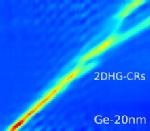
M. Failla, J. Keller, G. Scalari, C. Maissen, J. Faist, C. Reichl, W. Wegscheider, O. J. Newell, D. R. Leadley, M. Myronov, J. Lloyd-Hughes
New J. Phys. 18:113036 (Nov 2016) [ pdfLink opens in a new window ][ ref ]
Spin-split heavy-hole gases in strained germanium quantum wells were characterized by polarisation-resolved terahertz time-domain spectroscopy. Effective masses, carrier densities, g-factors, transport lifetimes, mobilities and Rashba spin-splitting energies were evaluated, giving quantitative insights into the influence of strain. The Rashba coefficient was found to lower for samples with higher biaxial compressive strain, while heavy-hole mobilities were enhanced to over 1.5x106cm2V−1s−1 at 3 K. This high mobility enabled the observation of the optical quantum Hall effect at terahertz frequencies for spin-split two-dimensional heavy-holes, evidenced as plateaux in the transverse magnetoconductivity at even and odd filling factors.
Papers from 2015 (JLH only)
- Narrow heavy-hole cyclotron resonances split by the cubic Rashba spin-orbit interaction in strained germanium quantum wells
-

M. Failla, M. Myronov, C. Morrison, D. R. Leadley, and J. Lloyd-Hughes
Physical Review B, 92:045303 (July 2015) [ pdf ][ supplemental info ][ ref ]
The spin-orbit interaction was found to split the cyclotron resonance of heavy holes confined in high-mobility, compressively strained germanium quantum wells. The interference between coherent spin-split cyclotron resonances was tracked on picosecond time scales using terahertz time-domain spectroscopy. Analysis in the time domain, or using a time-frequency decomposition based on the Gabor-Morlet wavelet, was necessary when the difference between cyclotron frequencies was comparable to the linewidth. The cubic Rashba spin-orbit coefficient β was determined via two methods: (i) the magnetic-field dependence of the cyclotron frequencies, and (ii) the spin-resolved subband densities. An enhanced β and spin polarization was created by tailoring the strain to enhance the spin-orbit interaction. The amplitude modulation of the narrow, interfering cyclotron resonances is a signature of spin coherences persisting for more than 10 ps.
- Interfacial and bulk polaron masses in Zn1-xMgxO/ZnO heterostructures examined by terahertz time-domain cyclotron spectroscopy
-
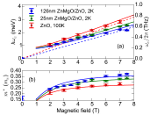
J. Lloyd-Hughes, M. Failla, J. Ye, S.P.P. Jones, K.L. Teo, and C. Jagadish
Appl. Phys. Lett. 106:202103 (May 2015) [ pdf ][ ref ]
The cyclotron resonance of polarons in Zn1-xMgxO/ZnO heterostructures (with 0.15<x<0.22) was studied by terahertz time-domain spectroscopy. Low-temperature magnetoconductivity spectra of the 2D electron gas at the Zn1-xMgxO/ZnO interface determined the polaron density, mass, and scattering rate. The cyclotron mass of 2D polarons was found to increase significantly with magnetic field B from 0.24me at B=2T to 0.37me at B=7.5T. A nonlinear cyclotron frequency with B was also observed for 3D polarons in ZnO. The findings are discussed in the context of polaron mass renormalization driven by the electron-LO-phonon and electron-acoustic phonon interactions.
- Structural, optical and vibrational properties of self-assembled Pbn+1(Ti1-xFex)nO3n+1-δ Ruddlesden-Popper superstructures
-
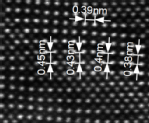
K. I. Doig, J. J. P. Peters, S. Nawaz, D. Walker, M. Walker, M. R. Lees, R. Beanland, A. M. Sanchez, C. F. McConville, V. R. Palkar, J. Lloyd-Hughes
Scientific Reports, 5:7719 (Jan 2015) [ pdf ][ Supp. Info. ][ ref ]
Bulk crystals and thin films of PbTi1−xFexO3−δ (PTFO) are multiferroic, exhibiting ferroelectricity and ferromagnetism at room temperature. Here we report that the Ruddlesden-Popper phase Pbn+1(Ti1-xFex)nO3n+1-δ forms spontaneously during pulsed laser deposition of PTFO on LaAlO3 substrates. High-resolution transmission electron microscopy, x-ray diffraction and x-ray photoemission spectroscopy were utilised to perform a structural and compositional analysis, demonstrating that n~8 and x~0.5. The complex dielectric function of the films was determined from far-infrared to ultraviolet energies using a combination of terahertz time-domain spectroscopy, Fourier transform spectroscopy, and spectroscopic ellipsometry. The simultaneous Raman and infrared activity of phonon modes and the observation of second harmonic generation establishes a non-centrosymmetric point group for Pbn+1(Ti0.5Fe0.5)nO3n+1−δ, a prerequisite for (but not proof of) ferroelectricity. No evidence of macroscopic ferromagnetism was found in SQUID magnetometry. The ultrafast optical response exhibited coherent magnon oscillations compatible with local magnetic order, and additionally was used to study photocarrier cooling on picosecond timescales. An optical gap smaller than that of BiFeO3 and long photocarrier lifetimes may make this system interesting as a ferroelectric photovoltaic.
Papers from 2014 (JLH only)
- Terahertz spectroscopy of quantum 2D electron systems
-
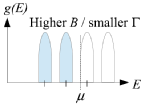
J. Lloyd-Hughes
J. Phys. D: Appl. Phys., 47:374006 (Sept 2014) [ pdf ][ ref ]
Terahertz time-domain spectroscopy permits the coherent motion of charges to be examined in a diverse range of two-dimensional semiconductor heterostructures. Studies of the THz conductivity and magnetoconductivity of two-dimensional quantum systems are reviewed, including cyclotron resonance spectroscopy and the transverse conductivity in the Hall and quantum Hall regimes. Experiments are described that demonstrate quantum phenomena at THz frequencies, principally coherent control and enhanced light–matter coupling in electromagnetic cavities.
- Influence of nonmagnetic Zn substitution on the lattice and magnetoelectric dynamical properties of the multiferroic material CuO
-
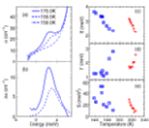
S.P.P. Jones, N.C. Wurz, M. Failla, D. Prabhakaran, C.F. McConville, J. Lloyd-Hughes
Phys. Rev. B, 90:064405 (Aug 2014) [ pdf ][ ref ]
Electromagnons were observed in the high-temperature multiferroic CuO even after Zn substitution disturbed the spin structure. The results demonstrate that electromagnons and dynamic magnetoelectric coupling can be maintained in disordered spin systems. Further, the dynamic lattice response of CuZnO was investigated by Raman and Fourier-transform spectroscopy, and was used to show strong spin-phonon coupling in both the antiferromagnetic low-temperature phase and the intermediate-temperature multiferroic phase.
- High-temperature electromagnons in the magnetically induced multiferroic cupric oxide driven by intersublattice exchange
-
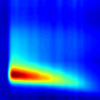
S.P.P. Jones, S.M. Gaw, K.I. Doig, D. Prabhakaran, E.M. Hétroy Wheeler, A.T. Boothroyd, J. Lloyd-Hughes
Nat. Commun., 5:3787 (Apr 2014) [ pdf with Supp. Info. ][ ref ]
Magnetically induced ferroelectric multiferroics present an exciting new paradigm in the design of multifunctional materials, by intimately coupling magnetic and polar order. Magnetoelectricity creates a novel quasiparticle excitation - the electromagnon - at terahertz frequencies, with spectral signatures that unveil important spin interactions. To date, electromagnons have been discovered at low temperature (<70K) and predominantly in rare-earth compounds such as RMnO3. Here we demonstrate using terahertz time-domain spectroscopy that intersublattice exchange in the improper multiferroic cupric oxide (CuO) creates electromagnons at substantially elevated temperatures (213-230K). Dynamic magnetoelectric coupling can therefore be achieved in materials, such as CuO, that exhibit minimal static cross-coupling. The electromagnon strength and energy track the static polarization, highlighting the importance of the underlying cycloidal spin structure. Polarized neutron scattering and terahertz spectroscopy identify a magnon in the antiferromagnetic ground state, with a temperature dependence that suggests a significant role for biquadratic exchange.
- Modifying the polarization state of terahertz radiation using anisotropic twin-domains in LaAlO3
-

J. Lloyd-Hughes, S.P.P. Jones, E. Castro-Camus, K.I. Doig, J.L. Macmanus-Driscoll
Optics Lett., 39 1121 (Mar 2014) [ pdf ][ ref ]
Polarization-resolved terahertz (THz) time-domain spectroscopy was utilized to examine the complex refractive index of lanthanum aluminate (LaAlO3), a rhombohedrally distorted perovskite that exhibits crystallographic twin domains. The uniaxial anisotropy of the refractive index was quantified. The ellipticity of THz radiation pulses after transmission through single domains indicated that LaAlO3 can be used as a quarter- or half-wave plate. The effective anisotropy of [001]-oriented LaAlO3 was found to be reduced when the material exhibited multiple, narrow twin domains.
